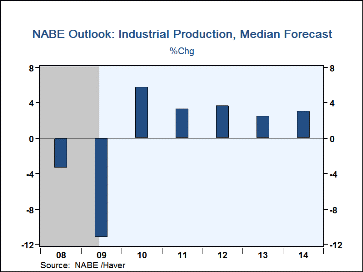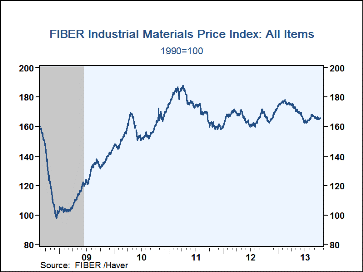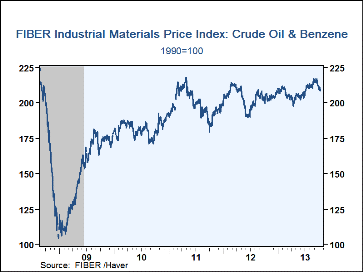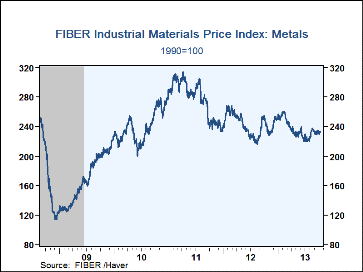 Global| Oct 14 2013
Global| Oct 14 2013FIBER: Industrial Commodity Prices Remain Trendless
by:Tom Moeller
|in:Economy in Brief
Summary
Most commodity prices indexes have moved sideways since the recovery from recession. Friday's industrial commodity price index, from the Foundation for International Business and Economic Research (FIBER), was 165.5, unchanged since [...]
Most commodity prices indexes have moved sideways since the recovery from recession. Friday's industrial commodity price index, from the Foundation for International Business and Economic Research (FIBER), was 165.5, unchanged since early-September.
Very recently there's been offsetting movement in two of the major price categories. To the downside have been prices in the crude oil & benzene grouping. Crude oil prices fell on Friday to $102.20 for WTI. That compares to a high of $110.15 in late-August. Prices for the petro-chemical benzene also reversed earlier strength. To the upside have been prices in the textile group where cotton and burlap prices have recovered following declines in early-September.
In the metals group, prices have been moving sideways. They are down, however, by roughly one-quarter since the 2011 high. Steel scrap prices have been trendless since the middle of last year. Aluminum and copper scrap prices recently firmed after declines this summer but they're still down roughly 10% versus last year. Prices in the miscellaneous group also have been moving sideways since June but they're down 15% since early last year. Recent strength in framing lumber costs has been offset by weakness in prices for structural panels. Natural rubber prices are down sharply from the early-September highs but also have been trendless during the last year.
 The current industrial output projection from the National Association
for Business Economics calls for 2.5% growth this year but then a pickup
to 3.1% in 2014. These growth rates are little changed, however, from
those since 2011 and thus suggest little support coming for industrial
commodity prices. During the last ten years there has been a 42%
correlation between the three-month change in prices and the change in
factory sector industrial production.
The current industrial output projection from the National Association
for Business Economics calls for 2.5% growth this year but then a pickup
to 3.1% in 2014. These growth rates are little changed, however, from
those since 2011 and thus suggest little support coming for industrial
commodity prices. During the last ten years there has been a 42%
correlation between the three-month change in prices and the change in
factory sector industrial production.
Commodity price data can be found in Haver's DAILY, WEEKLY, USECON and CMDTY databases.
| FIBER Industrial Materials Price Index (1990=100) | 10/11/13 | Y/Y % | 2012 | 2011 | 2010 |
|---|---|---|---|---|---|
| All Items | 165.5 | -1.1 | 166.4 | 173.0 | 157.9 |
| Textiles | 78.2 | 1.8 | 77.9 | 86.1 | 81.3 |
| Cotton (cents per pound) | 79.8 | 20.7 | 74.5 | 132.8 | 87.8 |
| Metals | 232.6 | -5.5 | 243.0 | 278.7 | 240.0 |
| Aluminum ($ per metric ton) | 1,772.0 | -5.1 | 2,019.6 | 2,400.9 | 2,172.1 |
| Copper Scrap (cents per pound) | 314.0 | -8.8 | 360.6 | 400.3 | 326.8 |
| Steel Scrap ($ per ton) | 324.3 | -6.7 | 366.7 | 412.6 | 326.5 |
| Crude Oil & Benzene | 209.0 | 1.2 | 204.1 | 199.3 | 182.0 |
| Crude Oil (WTI, $ per Barrel) | 106.4 | 18.3 | 94.2 | 95.0 | 79.4 |
| Miscellaneous | 206.1 | -0.7 | 205.3 | 190.6 | 179.1 |
| Framing Lumber ($ per 1000 board ft.) | 335 | 5.0 | 321 | 273 | 283 |
| Natural Rubber (cents per pound) | 176.0 | -13.1 | 211.9 | 262.3 | 182.9 |
Tom Moeller
AuthorMore in Author Profile »Prior to joining Haver Analytics in 2000, Mr. Moeller worked as the Economist at Chancellor Capital Management from 1985 to 1999. There, he developed comprehensive economic forecasts and interpreted economic data for equity and fixed income portfolio managers. Also at Chancellor, Mr. Moeller worked as an equity analyst and was responsible for researching and rating companies in the economically sensitive automobile and housing industries for investment in Chancellor’s equity portfolio. Prior to joining Chancellor, Mr. Moeller was an Economist at Citibank from 1979 to 1984. He also analyzed pricing behavior in the metals industry for the Council on Wage and Price Stability in Washington, D.C. In 1999, Mr. Moeller received the award for most accurate forecast from the Forecasters' Club of New York. From 1990 to 1992 he was President of the New York Association for Business Economists. Mr. Moeller earned an M.B.A. in Finance from Fordham University, where he graduated in 1987. He holds a Bachelor of Arts in Economics from George Washington University.










